matta
Well-known member
Hi Folks....
Well the title says it all.
I know the best way to avoid hum/buzz in rack, esp pres is to have the transformer outside of the rack. It also helps when you only put 2 pres in a rack and as FAR away from the power transformers as possible.
The problem is that in 2 racks I've built, to save money I've put 4 pres in a rack with the PSU and torrid. The problem in both cases is that the pres closest to the torrid have hum/buzz, which can only be the torrid, deduced by the facts:
1>I've tried 2 different PSU's, a JLM AC/DC and Peter C, both the same.
2>Not the grounding, since everything is grounded the same way and the ones furthers from the torrid are hum free.
3>Moving the torrid outside of the box clears the problem.
I have tried the following in an effort to lower the hum
1>Rotated the torrid to find the null and least amount of hum
2>Twisted the AC lines (makes no difference)
3> Tried a metal can, with no luck.
Mu-Metal shielding seems to be my best option as moving the torrid out the box is something I'd prefer not to do, if at all possible.
Now maybe I'm just being pedantic, because I've seen many other projects that do the same thing I've done and no one seems to have complained about hum issues from the torrid.
Here is a pic of my Green Pre.
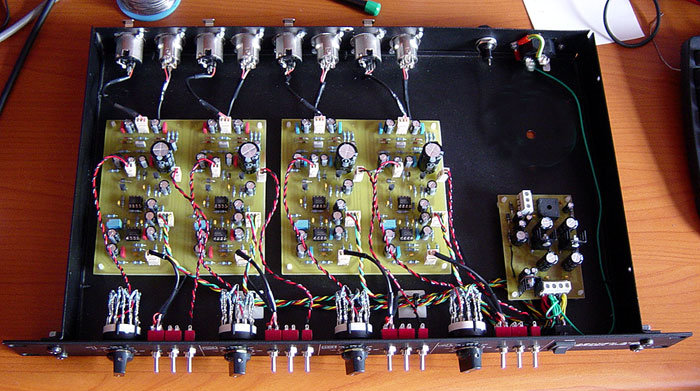
The Torrid is now where that mounting hole in the rack tray is.
What I did to eliminate a mic/external source as the issue I put a 150R resistor between Pins 2 and 3 and then cranked the gain to full gain (66dB), and recorded the outputs at +4dB directly into Pro Tools with the Fader set to 0dB and did a bounce down.
Here are the clips, Channel 1 is furthest from the Torrid, Channel 4 is the closest.
Green Pre Channel 1 (290kB)
Green Pre Channel 4 (290kB)
I then took the waves into Wavelab and looped them and did an FFT test and here are the graphs.
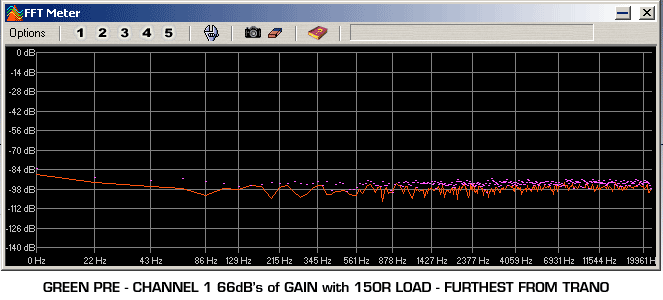
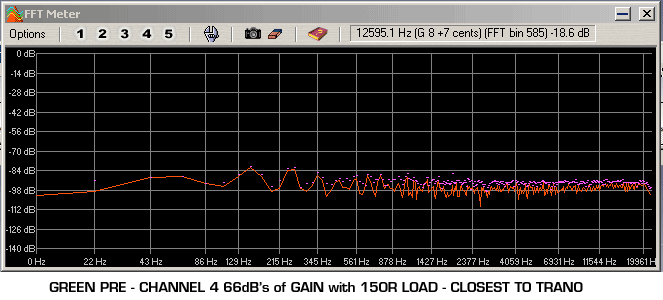
I tried the same test with my Spectratone (Spectra Sonics 101 Cards) rack and here are the samples and FFT results, Channel 1 being furthest away, 2 being closest.
SS101Channel 1 (530kB)
SS101Channel 2 (530kB)
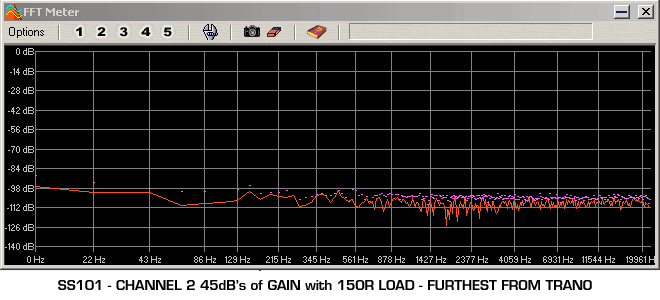
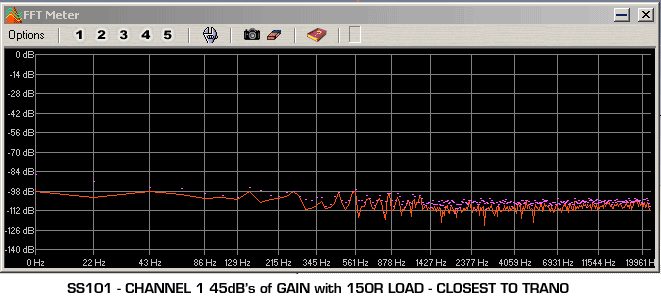
The graphs look pretty similar, but the buzz if more evident in the channel closest to the torrid.
How do these samples fair to you pres? Is the hum acceptable for 'real world' recordings? Are yours better/worse? Would love to hear more.
And should they be too loud, do you think a strip of mu-metal around the torrid would lower/eliminate it? And if so any idea where to get some metal tape/strip?
Sorry for all the questions, I'm just going mad here and need to see how I fair to others.
Cheers
Matt
Well the title says it all.
I know the best way to avoid hum/buzz in rack, esp pres is to have the transformer outside of the rack. It also helps when you only put 2 pres in a rack and as FAR away from the power transformers as possible.
The problem is that in 2 racks I've built, to save money I've put 4 pres in a rack with the PSU and torrid. The problem in both cases is that the pres closest to the torrid have hum/buzz, which can only be the torrid, deduced by the facts:
1>I've tried 2 different PSU's, a JLM AC/DC and Peter C, both the same.
2>Not the grounding, since everything is grounded the same way and the ones furthers from the torrid are hum free.
3>Moving the torrid outside of the box clears the problem.
I have tried the following in an effort to lower the hum
1>Rotated the torrid to find the null and least amount of hum
2>Twisted the AC lines (makes no difference)
3> Tried a metal can, with no luck.
Mu-Metal shielding seems to be my best option as moving the torrid out the box is something I'd prefer not to do, if at all possible.
Now maybe I'm just being pedantic, because I've seen many other projects that do the same thing I've done and no one seems to have complained about hum issues from the torrid.
Here is a pic of my Green Pre.

The Torrid is now where that mounting hole in the rack tray is.
What I did to eliminate a mic/external source as the issue I put a 150R resistor between Pins 2 and 3 and then cranked the gain to full gain (66dB), and recorded the outputs at +4dB directly into Pro Tools with the Fader set to 0dB and did a bounce down.
Here are the clips, Channel 1 is furthest from the Torrid, Channel 4 is the closest.
Green Pre Channel 1 (290kB)
Green Pre Channel 4 (290kB)
I then took the waves into Wavelab and looped them and did an FFT test and here are the graphs.


I tried the same test with my Spectratone (Spectra Sonics 101 Cards) rack and here are the samples and FFT results, Channel 1 being furthest away, 2 being closest.
SS101Channel 1 (530kB)
SS101Channel 2 (530kB)


The graphs look pretty similar, but the buzz if more evident in the channel closest to the torrid.
How do these samples fair to you pres? Is the hum acceptable for 'real world' recordings? Are yours better/worse? Would love to hear more.
And should they be too loud, do you think a strip of mu-metal around the torrid would lower/eliminate it? And if so any idea where to get some metal tape/strip?
Sorry for all the questions, I'm just going mad here and need to see how I fair to others.
Cheers
Matt



